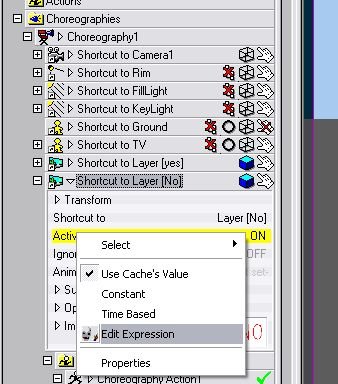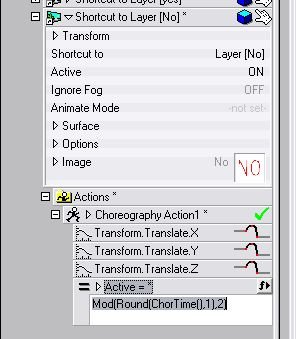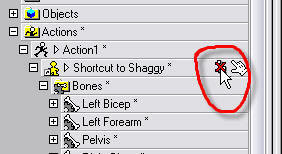-
Posts
1,248 -
Joined
-
Last visited
Content Type
Profiles
Forums
Events
Everything posted by Caroline
-
I was reading Dec 3d World, and there's an article in there about making the Caltex advert, that had a car made out of flies. So, seeing as I'm studying particles, I thought I'd have a go: [attachmentid=22919] It raised a number of questions - like did I do it the easiest way? I emitted fly sprites from the undecalled transparent Porsche, and applied a lot of force to make it go backwards, and then reversed the rendered TGAs. So you can't send particles along a path? I wanted the swarm to form a ball and then swarm along a path to form the car, but I could not get them to join up with the backwards rendered TGAs convincingly. If you send out particles, you have less control than if you drag them behind the emitter, but they don't look right if you drag them. Particles are pretty fun though. The Caltex advert is here (34mb): http://www.animallogic.com/commercials/cal...es/qt/flies.mov and the making of is here: http://www.animallogic.com/commercials/caltex/flies/ CarFlies.mov
-
Jim Talbot has done some videos on decalling a face, and the first video shows how to flatten - I've used this in v13, so it worked for me the way he showed: They are in zip files, so I guess they're windows only. Flatten Tutorial Features Tutorial Eyebrow Details Tutorial Eyelashes Detail Tutorial
-
Thanks for the link - some great reading in this and his other tutorials - I hadn't found these. Footsteps in the snow here we come!
-
I really enjoy modelling with splines - I'm making a huge (for me, anyway) model (the requisite newbie dragonish creature), and I really like being able to pull out a few points and adjust the shape of his tum, or add a few points and make the top of his head more lumpy. The challenge now is to look at my model and remove unnecessary splines. Some of the models out there are so elegant and spline-light. I think one of the tutorials that really helped me suddenly realize that I'm working in 3d space, but I hesitate to mention it, because it is 10 years old, and the decal bit at the end doesn't apply, is this Skylark one by Jeff Lew: http://www.hash.com/users/jsherwood/tutes/SkyLark.pdf And to keep it on-topic, it shows building a flat face, and adding extra points so that it's obvious where to hang other splines. It's not as good as Colin's Cooper face, because I don't think that Jeff had 5 point patches way back then, but making a flat face and pulling out the features is a very different approach. But if you can put together the definitive "what to do with splines, how to avoid creases, how to add new splines, how to get rid of existing ones", then you'll definitely be approaching enlightenment.
-
I've learned a lot about searching in the last few months - even before learning splining, I think it's the most useful basic skill! And I enjoy searching, because I will always learn something on a totally unrelated topic that will be useful next week. I've learned to put quotes ("") around everything that has a space, and in the forums, if I go to the search box on the main forum page, to search for separate words with a + sign in front of them, so you get both words in the search. As for example I just looked for +spline +tutorial, checked the titles of the many threads, and came up with this thread, which is talking about the same sort of thing: http://www.hash.com/forums/index.php?showtopic=23013&hl= and this one, which is a wink tutorial about avoiding creases, but you're probably past this stage: http://www.hash.com/forums/index.php?showtopic=13938
-
Thank you for pointing out this difference to me. I've spent a lot of time just doodling with splines to get the feel for them, and adding an extra point to a spline I'm going to cross, so that I definitely don't join onto the same spline. I looked in the Technical Reference manual for "Shift A" and came up with this that explains it: http://www.hash.com/htmlHelp/v12.0/CustomHtml/Join.htm So in summary, I think, if you have an existing spline with 2 points, and you start a new spline that is going to cross the existing spline, if you just A onto the existing spline, the new spline will become part of the existing one. But if you Shift A, then the new spline will be a second separate spline. I find the Technical Reference Manual, which comes on the disk, often has useful snippets of knowledge. It is often frustrating, because you can't read it easily, but if you kinda sorta know what you're looking for, it is often there.
-
Warning - This is not for the faint-hearted, but it does seem like an elegant solution. I have been wanting to make Expressions work for me, and in this case they could. (I don't know how Expressions affect render times.) This is a movie of two Decals acting as Layers with an Expression on the No Layer. [attachmentid=22472] I have a simple 4 spline model, and a "Yes" Decal Layer in front of that, and a "No" Decal Layer in front of that. On the properties of the "No" Decal Layer, in the Choreography, I right clicked Active, and chose Edit Expression. [attachmentid=22474] Then, after a long trial and error and searching and head scratching, I came up with: Mod(Round(ChorTime(),1),2) [attachmentid=22475] I set the Chor Time to 5:00, and it seems to work - it should work indefinitely as well, with no change needed, no matter how long the Chor Time is. (I hope!) This will take the Choreography Time, Round it up, and Modulus it by 2, so that every second, the "No" Decal Layer Active Property will be Off, and will not render, showing up the "Yes" Decal Layer behind it. I have no mathematical ability, and I have no doubt a mathematical mind would be able to change the 1 second to something else, but I couldn't. DecalExp.mov
-
That dog play is really cute. I'm sure you have reels of footage from your dog, and I found this dog walk clip: From Getty Images which is very close to your's, except I wonder if there is a slightly longer delay in bringing up the front paw after the rear paw. But I was definitely wrong about the both legs on same side issue, and you're the director! They're both looking great. Are you compressing the mov with Sorensen 3? It seemed quite a large file size for a short clip.
-
I hope you don't mind me critiquing, Steve - you've taken this a lot further than I could. I hope you get your action blend problem sorted. I don't think that front and rear paws should leave the ground at the same time. Also, should the left front and left rear should be raised together? I thought the only animals that do that are the giraffe and the camel. I believe that at some point in the walk cycle, the left rear and right front are raised at the same time. I've been watching my dog - he's an old Maltese with much hair, so is probably very different to a dalmation in his prime, but when he walks, I can't see a curl of his rear end - I could imagine that your sort does, though, and the base of his tail has a definite left/right motion, rather than an up/down. I think there's a sideways sway in the backbone. And I love your dog! [Edit] I've been trying to find some video, but all I've come up with so far is: http://video.google.com.au/videoplay?docid...594988272&q which is a bit too blurry and fast. (I look for "Getty" + "dog") You may have more luck if you go to The Getty Images Site and search for "dog" - I found a couple that had clearer dogs.
-
Do you mean like this? [attachmentid=22413] If so: First, when you create your Action - make sure "Show More than Drivers" is on. [attachmentid=22412] This will let you select individual named groups in an Action. You can do the same thing in a Choreography for each model in the Chor. In the model window, I grouped and named the patches in the middle of Thom, and followed the 4 steps I wrote above. The transparency is also in the Surface Properties which I set in the Action at frame 1:00 to 0% and at frame 2:00 to 100%. Not a drag - just let me know where I'm not understanding your dilemma! color.mov
-
This probably doesn't help, because it's cartoon, but it's always fun to look at anyway: Preston Blair Four Legged Movements from ASIFA Animation Course Also a couple of dog cycles from Muybridge: http://bowlingsite.mcf.com/Movement/locoindex.html http://www.cmp.ucr.edu/exhibitions/dogdays/muybridge.html
-
1. Make sure you have the property triangle showing in the Project Workspace Panel: Change Tools Menu > Options > Global > Show Property triangle. 2. Create an Action for your model. 3. Click the + next to Action1, then click the + next to Action1 (in the Project Workspace Panel), then click the triangle next to Shortcut to Your Model. 4. Click the triangle next to Surface and click on the Diffuse Colour. If you want the colour to change over time, then, for example, if you are using Thom who is yellow, you can change the Action Frame (down at the bottom of the screen) to 10, and then change the Diffuse Colour to blue, then change the Frame to 20, then change the Diffuse Colour to red. He will then over time gradually blend colours. To change the colour from yellow to blue abruptly, you need to change the Frame to 9, and make sure the colour is yellow, then OK. Same for Blue to Red - change the Frame to 19, and make sure the colour is Red. If you've done TAOA:M, Exercise 12 shows you how to make a pose, so you could also make a pose slider for all the different colours that you want him to be.
-
Looks great. I'm using Internet Explorer 7, and I had trouble with the default Quicktime plugin (the forum Quicktimes work for me, but nothing from any other source). I was able to view the wmv version.
-
Thanks, Scott - I do forget the Balance Rigid. I expect it's useful somewhere. Logrus - just a suggestion, if you're still having problems - perhaps it would help if you reset all your settings (Help Menu > Reset Settings), and just started again slowly. You're way ahead of me using those buttons at the bottom (the Key Bone, etc). I did my Shaggy exercise without touching any of them, as I don't know yet what each one does, and, personally, I can only learn one thing at a time. Those buttons may be putting in a variable that you don't yet need.
-
I've been trying to find some screen capture software that actually works, and doesn't take 68mb per second. That may take time.... So, I've downloaded Wink, and this is my first attempt, so please forgive it. This demonstrates just moving Shaggy's Right Foot, then his Left Foot (and I also had to move his hips to get the right position.) I moved and rotated both his feet. Right foot at 0:10, and Left Foot at 0:20. You can see what happens here: www.popsyland.com/hash/shaggy.htm (It's about 0.7mb, so not big). There are green left and right arrows at the bottom right to navigate to the next screen capture. Try reproducing what I did there in those few keyframes, and you may start to see why the left foot is moving when it "shouldn't". The first half dozen times you watch it, it probably won't make sense, but once you tried exactly that a few times, then I hope it will.
-
I've only used Default (spline) and Hold so far. I couldn't find much either, but this link is From The Technical Manual
-
Hi, Logrus - I'm a new user, too, and I don't really understand your first paragraph. What I learned and did a lot of experimenting with, was the channels for the animating. I'm glad you found that movie Keeping Bones from Wandering - I watched that one over and over. And then I experimented a lot. The constraints I did EXACTLY as the manual, remembering at some stage to turn the constraints off when he lets go the handle. Those in the manual were the only constraints I used. I didn't change the standard rigging, and used only what came in Shaggy. I also trashed a lot of projects, I found sometimes it's just easier to start again, with the new things that I've learned by doing. That foot. If you use the left foot for the first time at 2.00, then you're going to have a gentle slope in the channels from frame 0.00 to 2.00. This means that the foot is going to move very gradually the whole time. So what I did was to wiggle the foot at 1.25 (just before 2.00). This means that the spline in the channels should be even until 1.25, then start the move to 2.00. HOWEVER, most times I forgot the pre-wiggle, and had to fix it up with a point in the channel editor. Just to give you an idea, here's a screen catch from my Shaggy: [attachmentid=21890] In this picture, it's the timeline for the Left Foot Target. The green one is the easiest to follow, as it's the Translate.Y channel, which goes up and down. You can see exactly where the Left Foot Target goes up at 3.15 - if you want it to go up and down, you just click in the right place and drag the points. Note:- (if you're using the channels) When you have a keyframe along the spline in the channels, then you can drag it up and down only. To drag it to left and right to get the timing right, you have to hold down the '1' key (not the numeric 1). Disclaimer:- I am a new user and may be doing things differently from the 'pros'! It is a difficult exercise and took me a LONG TIME to sort out, with lots of searching on the forums, and experimentation. I think it's the only one like that in the book, though, so even if you leave it to the end, then you may not learn more about animating. However, if you're really sick of it, then rather than get over-frustrated, then leave it and go on with the next one.
-
Hi, Logrus - I haven't myself had the problem of losing keyframes, but I did a search and found this thread which talks about a missing keyframe. But as you're not having that problem any more, perhaps it's gone away. The other problem of the left foot moving before it's supposed to, does sound like a lack of keyframe on the left foot. Personally I didn't really understand how these bones were moving until I looked at the channels. If you click on a bone in the timeline, you will see the keyframes for that bone. Under the timeline there are a series of buttons: [attachmentid=21841] The left button will show you the channels for that bone. So, for example, if you click on the Left Foot Target Bone, and look at the Transform.Translate.Y channel, it will show the spline for movement in the Y channel. This means that when the spline goes up, the Y value goes up, so the Foot Target goes up. If you look at the channels, you can very easily see unwanted spline movement where key frames have not been properly set. There is a short movie somewhere, that might help, but I can't find it, I think by Robert Holmen, about Keeping Bones from Wandering. It's late here, so I hope this makes some sense so you can find something to search on - there's so much information here in the forums.
-
Hi, eazail - link to the A:M 13.0m Installer is: Link to A:M 13.0m Installer I look forward to seeing you in the New User's forum doing TAOA:M (The Art Of Animation:Master)!
-
Thanks, John - coincidentally I had just finished my Flower for TAOA:M Exercise 9, and I was looking at the petals thinking Wouldn't it be neat to press a petal and play a note. Then you pointed out that I could use a Dope Sheet. I used 2 dope sheets, one for the high notes and one for the lower notes, for Daisy, posted here: Daisy.mov (1.27mb) (I hope I've linked that properly - it's under Newbie Ex 9 if I haven't!) I could not yet work out how to assign a made up word eg. noteA1 to a particular phoneme, so for the words I typed in dd bb gg etc and manually assigned "a single phoneme" to each word. Great fun. Chrury, you're probably looking for better sound quality, but I used Noteworthy to create the midi, then used Wavepad to record the midi to wav. I couldn't find a converter that would work.
-
3d ArtZ Website (Mike FitzGerald(?)) has a free .tga to QT .mov conversion program, called Image2Movie. I like rendering to tga to experiment with filters etc in Photoshop, then joining them together. There's a pencil animation program with a free option - Plastic Animation - where you can sketch an animation, then output to tga, blend with a background in Photoshop, then use Mike's program to put it together.
-
Hi - I'm Caroline, about to start work on TaoAM. I'm from Cornwall, UK, originally, but have landed upside down in Queensland, Australia (heat, venomous snakes, poisonous spiders.... love it). I've decided to learn CG to keep one step ahead of my son, who thinks I'm past it because I'm just not interested in remotely shutting down his sister's computer for a joke. Having obsessively printed out everything on the internet, I am really impressed by A:M resources, and am looking forward to striking a pose.














